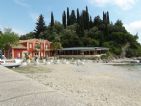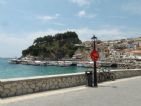
Parga: architecture and business
17/05/2013 9:27:24
Many people wonder why the Archduke spent so much time in Parga. One of the possible reasons, after studying Paxos and Antipaxos, it is believed that he was interested to see the contrasts of an Ottoman culture and population at that time in Parga.
Since the beginning of the twentieth century Parga was again part of the kingdom of Greece. It is said that the Greeks who exiled, most to the Ionian Islands, when they came back, they returned the bones of their ancestors to the cemeteries of Parga. Also brought back the icons of many churches in this area, and which today can be admired in the museum of Parga, attached to the Cathedral.
In Parga we were welcomed by the Deputy Mayor of the city, Yannis Klotsonis, who has been kind enough to join us for the last few days in some of the visits introducing us some specialists.
The first thing that strikes the visitor to the city is the beauty of the bay, the clarity of the water, the surrounding hills and the islands in the middle of this small bay.
.jpg) In the old town there are few wide streets. The wider corresponds to what was the old riverbed.
In the old town there are few wide streets. The wider corresponds to what was the old riverbed.
The old main street, which mentioned the Archduke, runs parallel to the coast and ascends the hill leading to the castle. Today is full of business for tourists. In it we find the image with the church that took the Archduke and, at the top, we note that there is no longer the minaret, which was at the time. We also see the detail of the windows in a typical house of this street.
.jpg) Also noteworthy are the steps leading up to the main entrance of the houses, made for the house’s defense in case of enemy attack. We see on the right a staircase from the main street, and down a staircase renovated corresponding to one of the stairs photographed by Archduke and another just by the oil production factory-museum in Parga.
Also noteworthy are the steps leading up to the main entrance of the houses, made for the house’s defense in case of enemy attack. We see on the right a staircase from the main street, and down a staircase renovated corresponding to one of the stairs photographed by Archduke and another just by the oil production factory-museum in Parga.
At the front we find a ride that was built on the old beach, in front of the old city where is the dock for boats. If we look from the pier to the south you can see the end of the ride and it is observed that the house at the end of it was destroyed.
 From the dock area we see the islets like in the image of the Archduke. We can also see the castle, and also a picture of them taken from the right bank, near the castle.
From the dock area we see the islets like in the image of the Archduke. We can also see the castle, and also a picture of them taken from the right bank, near the castle.
The town of Parga is now fully oriented to the tourism. We know that primary activities also occur, but most people work in tourism. There is a hotel in the city that has been dedicated to the figure of the Archduke: The Salvator Hotel, where we were invited by the owner, Adonis, and where they have one of the original books of Parga.
Parga consists of three small bays. In the second hill stands the church of Ayos Athanasios. On the ascent we find beautiful olive trees.
Ayos Athanasios church, like most churches that we find is very simple. We can no longer see the view of Parga because there is plenty of vegetation hiding the edge of the hill.
Finally we visited the castle of Parga which is an essential part of it, both historically and scenically. First we see the entrance of the castle and the town of Parga from that point.
 After fifty meters up we reached the top of the hill and the castle. Inside the castle you can see the traditional cobbled streets and see some canyons near the walls.
After fifty meters up we reached the top of the hill and the castle. Inside the castle you can see the traditional cobbled streets and see some canyons near the walls.








.jpg)
.jpg)
.jpg)
.jpg)
.jpg)
.jpg)


























.jpg)
.jpg)
.jpg)
.jpg)
.jpg)
.jpg)
.jpg)
.jpg)







